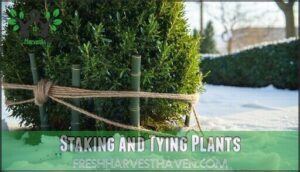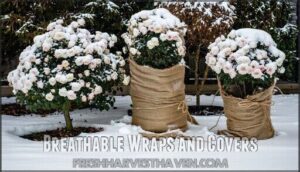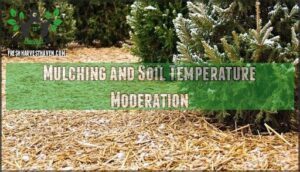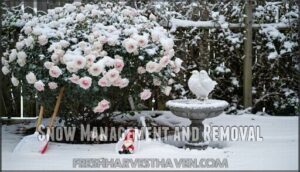This site is supported by our readers. We may earn a commission, at no cost to you, if you purchase through links.
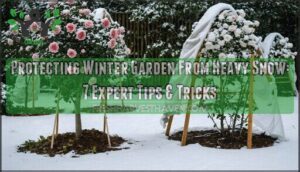
You’ll want to stake tall plants, wrap tender shrubs in breathable fabric, and build A-frame covers over delicate specimens.
Think of snow as nature’s double agent—a light layer insulates plants like a cozy blanket, but heavy accumulations turn into garden crushers.
Focus on your most vulnerable plants: roses, young trees, and anything that bends easily.
Don’t forget root protection with thick mulch around plant bases.
When snow piles up, gently brush it off branches before they snap under the weight.
Smart preparation beats spring regrets every time.
Table Of Contents
- Key Takeaways
- Winter Garden Preparation
- Plant Hardiness Ratings
- Structural Supports and Protection
- Insulation and Root Protection
- Snow Management and Removal
- Seasonal Preparation and Protection
- Plant Selection and Winter Care
- Winter Weather Impact and Mitigation
- Garden Tool and Equipment Winterization
- Frequently Asked Questions (FAQs)
- Should I cover my plants if it snows?
- How to protect plants from a hard freeze in winter?
- Should I water my plants before I cover them for a freeze?
- What happens if snow stays on plants too long?
- Can I use salt to melt garden snow safely?
- Should I water plants during winter cold snaps?
- How do I protect newly planted trees first winter?
- When should I remove winter plant protection covers?
- Conclusion
Key Takeaways
- Start your winter prep in autumn – You’ll need to stake tall plants, wrap shrubs in breathable fabric, and build A-frame covers before the first snowfall hits, not after damage occurs.
- Focus protection on vulnerable plants – Prioritize roses, young trees, and anything that bends easily under weight, while hardy perennials can handle winter with minimal intervention.
- Remove heavy snow gently and quickly – You should brush snow off branches within 24 hours using upward sweeping motions to prevent breakage, but avoid shaking or hitting plants.
- Create proper insulation systems – Apply 4-6 inches of mulch around plant bases and use burlap wrapping to protect graft unions and tender species from temperature swings.
Winter Garden Preparation
You’ll need to assess your garden’s vulnerable plants before winter hits hard.
Creating a detailed inventory and understanding your yard’s unique conditions will help you protect the right plants with the right methods.
Plant Inventory and Mapping
Before winter strikes, create your plant inventory to identify which green friends need extra TLC.
Walk your yard systematically, noting each plant’s location and condition.
Your mapping mission includes:
- Species Vulnerability – Document fragile plants like arborvitae and hydrangeas that struggle under snow loads
- Microclimate Mapping – Mark warm spots near walls and cold zones where wind funnels through
- Protection Planning – Group plants by hardiness levels for efficient material listing and targeted care
This plant mapping becomes your winter survival blueprint, ensuring no vulnerable plants get forgotten when the forecast turns ugly.
Microclimates and Hardiness Zones
Understanding your property’s unique conditions helps you make smarter plant choices and protection decisions.
USDA zones provide baseline hardiness ratings, but microclimates within your yard can vary dramatically. South-facing walls create warmer pockets, while low spots become frost traps.
Zone mapping your garden reveals these local variations, considering sun exposure, wind patterns, and moisture levels. These microclimate differences affect plant selection and winter survival rates substantially.
Preparing adequately involves understanding soil composition for ideal growth and making informed decisions based on your yard’s specific microclimates.
Vulnerable Species Identification
Your garden’s most vulnerable plants often hide in plain sight.
Focus on fragile tree ID first – young maples, fruit trees with grafted plant care needs, and anything showing weak branching patterns.
Bushy plant focus should include arborvitae, hydrangeas, and other soft plants that collect snow like magnets.
Cold-sensitive plants near your home’s foundation need extra attention for snow damage prevention.
These sensitive plants face the highest risk of plant breakage, making plant vulnerability assessment your winter garden’s foundation.
Plant Hardiness Ratings
Understanding your plants’ hardiness ratings helps you prioritize winter protection efforts effectively.
You’ll save time and resources by focusing on the plants that truly need help surviving heavy snow and freezing temperatures.
Hardy Perennials and Minimal Protection
Hardy perennials pack serious hardiness benefits, surviving temperatures down to -30°F with minimal fuss.
Your garden’s toughest plants laugh at winter’s worst tantrums while tender varieties need your protection plan.
You’ll find these winter warriors like daylilies and coneflowers bounce back beautifully after heavy snow melts, thanks to natural insulation from snow cover and resilient root systems.
Their snow tolerance means you can skip elaborate snow protection methods.
- Natural antifreeze compounds prevent cellular damage during freeze-thaw cycles
- Deep root systems extend below frost line for reliable winter garden protection
- Dormancy mechanisms shut down growth to avoid snow damage prevention issues
- Quick spring recovery using stored energy eliminates replacement costs
Most hardy perennials need only basic mulching for minimal intervention success.
Semi-Hardy Plants and Moderate Protection
How can you shield plants that handle moderate cold but struggle with heavy snow?
Semi-hardy plants need strategic moderate protection to survive winter’s harsh conditions.
Use burlap wrapping around vulnerable shrubs to create effective snow protection methods.
Install mesh covers or cloche protection over smaller plants to prevent snow accumulation.
These techniques enhance cold tolerance while protecting plants from heavy snow garden conditions without requiring extensive winterization efforts.
Tender Plants and Significant Protection
Tender plants can’t handle temperatures below 32°F and need your most aggressive protection strategy. Think of them as house guests who forgot their winter coats—they’ll need indoor storage, heating cables, or greenhouse options to survive.
Protection methods for tender plants:
- Indoor storage – Move container plants to garages, basements, or heated spaces before first frost
- Cold frames and plant covers – Create protective structures with A-frame designs and insulating materials
- Heating cables – Install underground warming systems for in-ground tender plants that can’t be relocated
Structural Supports and Protection
When heavy snow threatens your garden, you’ll need sturdy structural supports to prevent broken branches and crushed plants.
Don’t let winter’s weight crush your garden dreams—smart supports save your plants.
Strategic staking, A-frame covers, and breathable wraps create a protective shield that helps your plants survive winter’s weight.
Staking and Tying Plants
Installing supports around shrubs and trees before winter hits prevents snow-induced breakage.
Use bamboo stakes or metal posts with plant ties and twine for secure anchoring.
Tie flexible branches into conical shapes that shed snow naturally.
This tying technique keeps branches from splaying under weight.
Focus on soft, bushy plants like arborvitae that can’t handle heavy loads.
Understanding how to create beneficial microclimates can also help protect plants from winter damage.
Proper staking supports give your plants the backbone they need to withstand winter damage and benefit from beneficial microclimates with secure anchoring.
A-Frame Structures and Snow Shedding
A-frame structures offer superior snow load management through their triangular design, which distributes weight evenly and prevents collapse.
Build your A-frame with 2×4 lumber and angle optimization between 45-60 degrees for ideal snow shedding. Material selection matters—polycarbonate panels shed 95% of accumulated snow automatically.
These A-frame structures provide excellent structural integrity while requiring minimal snow removal compared to flat-roof alternatives. You can find specialized snow shedding products to enhance your A-frame’s performance.
Breathable Wraps and Covers
How can breathable wraps protect your plants without creating a greenhouse effect? Proper ventilation prevents deadly overheating while shielding delicate foliage from harsh winter conditions.
Essential breathable cover materials:
- Burlap Benefits – Natural fibers allow air circulation while blocking wind and heavy snow
- Mesh Options – Landscape fabric and frost blankets provide protection without trapping moisture
- DIY Wraps – Layer breathable fabrics loosely, securing with twine to prevent direct contact with branches
For readily available options, consider using breathable plant wraps for effective protection.
Insulation and Root Protection
Your garden’s roots need proper insulation to survive freezing temperatures and heavy snow loads.
Think of mulch as a cozy blanket that keeps soil temperatures stable while protecting plant crowns from frost damage.
Mulching and Soil Temperature Moderation
Why does proper mulch selection matter more than you think?
Your garden’s survival depends on the right insulating mulch creating a protective barrier against temperature swings.
Apply a 4-6 inch mulch depth using straw mulch, shredded leaves, or wood chips for effective soil temperature moderation.
Consider garden straw options for your mulching needs.
This prevents dangerous frost heave that damages root systems during freeze-thaw cycles, ensuring your plants emerge healthy come spring.
Compost and Soil Enrichment
Before winter arrives, boost your garden’s foundation with quality compost.
Perform soil testing to check nutrient content and soil pH levels.
Add a thin layer of organic matter like aged compost to improve soil structure.
Mix it gently into topsoil, creating a nutrient-rich base.
Healthy soil helps plants absorb spring nutrients more effectively, giving them strength to weather winter’s challenges ahead with a stronger foundation.
Graft Union Protection
Grafted trees need extra care where the rootstock meets the scion – that’s your bud union. This vulnerable spot can suffer serious damage when temperatures drop below freezing.
Here’s how to shield your graft location:
- Burlap Wrapping – Wrap the union with breathable material, extending coverage 6 inches above and below the graft site for complete rootstock protection.
- Insulating Mounds – Build soil berms around the base, then add straw or leaves to create natural insulation that prevents freeze-thaw cycles.
- A-Frame Structures – Install wood frames over young grafted trees to shed snow load and provide structural protection against heavy accumulation.
Snow Management and Removal
When heavy snow accumulates on your garden plants, you’ll need to act quickly to prevent branch breakage and permanent damage.
The key is removing excess snow gently while avoiding harm to neighboring plants and protecting your garden from salt and equipment damage, and ensuring the garden is safe from further harm is crucial.
Excess Snow Removal and Plant Damage Prevention
After heavy snowfall, you’ll need to act quickly but carefully. Snow Weight Effects can snap branches within hours, making Post-Snow Assessment essential for identifying Branch Breakage Risks before they worsen.
| Snow Removal Method | Best Practice |
|---|---|
| Broom Technique | Use upward sweeping motions |
| Hand Removal | Start from bottom branches up |
| Timing | Remove snow within 24 hours |
| Avoid Shaking | Never shake or hit branches |
| Load Limits | Remove when snow exceeds 2 inches |
Gentle Snow Removal prevents snow removal damage while protecting your investment. Use snow removal plants strategies that work with nature, not against it.
Heavy snow removal requires patience—rushing leads to snow damage prevention methods failure. Snow load prevention starts with immediate action after storms.
Salt-Laced Snow and Garden Protection
Road salt creates a minefield for your winter garden.
Salt-laced snow carries deicing chemicals that cause salt toxicity in plants, increasing leaf scorch by 35%.
Create salt barriers using burlap screens or raised beds above 8 inches to block runoff management issues.
Consider de-icing alternatives like calcium magnesium acetate for walkways.
After winter, conduct soil remediation with gypsum applications to reduce sodium levels by 35% and restore garden health from accumulated salt damage.
Snow Blower Safety and Garden Care
When operating your snow blower, you control where trouble lands.
Smart snow clearing protects your garden investment while keeping walkways safe.
Here’s your snow removal playbook:
- Plant Deflection – Angle your snow thrower away from shrubs and trees, directing discharge toward open lawn areas
- Reflector Stakes – Mark garden bed edges before winter arrives to avoid buried surprises during clearing
- Blower Direction – Maintain 6-foot clearance from delicate plants when choosing your snow placement path
- Avoiding Impact – Move slowly near landscaping, watching for hidden branches that could jam your machine
Seasonal Preparation and Protection
You’ll need to start your winter prep before the snow flies, not after it’s already piling up on your plants.
Smart timing makes all the difference between healthy plants that bounce back in spring and damaged ones that struggle to recover, highlighting the importance of smart planning.
Autumn Watering and Ground Freezing
Why wait until spring to discover winter’s harsh lessons?
Deep root watering before ground freezing creates a moisture reservoir that sustains plants through freeze-thaw cycles.
Fall hydration benefits include preventing dehydration when roots can’t access frozen soil.
Monitor soil moisture levels and water thoroughly until the ground hardens – this simple garden winterizing tip protects plants from snow damage and winter stress.
Winter Pruning and Disease Prevention
Winter pruning timing matters more than you think. Late winter cuts when temperatures drop below 5°C reduce bacterial infections and boost spring growth by 20-35%. Smart pruning timing also helps with snow load reduction on vulnerable branches.
Here’s your winter pruning checklist:
- Pruning Timing: Schedule cuts for late February when sap flow is minimal and frozen branches are easier to identify
- Disease Identification: Remove mummified fruit and infected wood to prevent 80% of spring fungal outbreaks
- Tool Sanitization: Clean pruning tools after each cut to reduce disease transfer by 90%
- Wound Treatment: Make clean, angled cuts under 2cm to minimize desiccation risks during freezing weather
- Preventative Sprays: Apply dormant oil after pruning to suppress 75% of overwintering pest eggs
Clean cuts heal faster, and removing diseased branches now means healthier growth when spring arrives.
Conifer and Evergreen Windbreaks
Smart evergreen placement creates natural windbreaks that reduce snow loads on vulnerable plants.
Position conifers upwind from tender shrubs to deflect harsh winter winds.
Strategic windbreak design blocks 50-80% of wind velocity within a protective zone extending 10 times the barrier’s height.
| Windbreak Species | Best Placement | Maintenance Needs |
|---|---|---|
| Spruce/Fir | North/Northwest edges | Minimal pruning, snow removal |
| Pine varieties | Property perimeters | Annual health checks |
| Arborvitae hedges | Garden borders | Shape pruning, ice removal |
Proper evergreen windbreaks control snow drift patterns while providing year-round winter wind protection for your garden’s most delicate plants.
Plant Selection and Winter Care
Choosing the right plants for your climate and properly winterizing them makes the difference between a thriving spring garden and costly replacements.
Smart plant selection paired with targeted protection keeps your garden healthy through heavy snow and freezing temperatures, which is crucial for a thriving spring garden.
Cold-Hardy Plant Selection
Your garden’s resilience starts with choosing native varieties that thrive in your region’s harsh conditions.
Cold-hardy plants with proven regional adaptation require minimal winter protection, saving you time and effort. Select species known for pest resistance and natural cold tolerance—they’ll bounce back stronger after heavy snow.
Look for plants offering winter interest through colorful bark or persistent berries. These cold-tolerant species basically become your garden’s insurance policy against unpredictable weather patterns.
Container Plant Protection and Grouping
Container plants become sitting ducks when winter arrives, but smart grouping creates a protective fortress.
Move containers to sheltered locations like garages or against south-facing walls. Cluster pots together—grouping benefits include shared warmth and easier maintenance.
Wrap containers in bubble wrap or burlap for insulation methods that prevent root freeze. Reduce watering strategies since dormant plants need less moisture.
Consider container material too; ceramic cracks while plastic survives freezing temperatures better. Well-draining soil prevents root rot in winter, which is essential for plant survival.
Climbing Rose and Bush Rose Winterization
Roses take a beating when winter weather rolls in, but proper preparation keeps them thriving.
Start your climbing rose prep by bundling canes with twine securing them against wind damage. Bush rose pruning to 30 inches prevents breakage from heavy snow loads.
Create soil mound protection around the base, covering graft unions with 8-12 inches of mulch or soil. Choose hardy rose variety choices for your climate zone.
Apply winter cover methods like burlap wrapping to protect plants from snow damage while ensuring breathability to prevent rot.
Winter Weather Impact and Mitigation
Winter weather brings three major threats to your garden: sun damage, wildlife feeding, and heavy snow loads that can break branches.
Understanding these challenges helps you protect your plants before damage occurs, saving you time and money come spring, by addressing issues like wildlife feeding.
Sunscald and Winterburn Prevention
Although winter sun seems harmless, it creates serious problems for your plants through sunscald and winterburn damage. Both conditions occur when plants can’t replace moisture lost through their leaves and bark.
- Apply anti-desiccant sprays to evergreens before winter to reduce moisture loss
- Use reflective wraps around tree trunks to prevent temperature fluctuations
- Position vulnerable species in shady locations away from harsh winter sun
- Maintain proper watering schedule through fall for adequate plant insulation
To mitigate these issues, consider the plant’s cold-hardy varieties for better survival.
Hungry Wildlife and Garden Protection
Winter transforms hungry critters into garden raiders. Deer browsing, rabbit damage, and vole control become critical when snow limits natural food sources.
Install 7-foot fencing for deer, 24-inch barriers for rabbits. Wire shelters around vulnerable plants prevent animal browsing effectively.
To protect specific plants, consider using individual plant fencing.
| Wildlife Threat | Protection Method | Key Features |
|---|---|---|
| Deer browsing | 7-foot tall fencing | Posts 4 feet from plants |
| Rabbit damage | 24-inch wire barriers | Bend base 90° underground |
| Vole control | Hardware cloth wraps | Bury 6 inches deep |
Combine physical barriers with repellents like Liquid Fence. Alternate scent products monthly to prevent wildlife adaptation.
Strategic bird feeding stations draw critters away from prized plants while providing winter sustenance.
Heavy Snow and Ice Damage Prevention
While wildlife can nibble your plants, heavy snow poses a more immediate structural threat.
Snow accumulation creates dangerous snow load that can snap branches and compromise your garden’s structural integrity.
Here are three critical snow load management strategies:
- Monitor snow weight – Remove snow when it reaches 6 inches deep on evergreen branches
- Practice gentle snow removal tips – Use a broom to brush upward, never shake or hit branches
- Focus on plant de-icing – Clear ice formations before they add excessive weight to vulnerable limbs
Branch breakage from ice damage can destroy years of growth in minutes.
Garden Tool and Equipment Winterization
Your garden tools work hard all season and deserve proper care before winter arrives.
Protecting them from freezing temperatures and moisture prevents rust, damage, and costly replacements when spring gardening season returns.
Tool Storage and Maintenance
Smart gardeners know that proper tool maintenance prevents costly replacements and guarantees peak performance.
Start your inventory management by cleaning tools thoroughly, removing dirt and debris. Apply rust prevention oils to metal surfaces after each use. Store cleaned equipment in dry locations to prevent corrosion damage.
| Tool Category | Maintenance Task | Storage Location |
|---|---|---|
| Cutting Tools | Sharpening blades, oil hinges | Heated garage/shed |
| Hand Tools | Remove rust, apply protective coating | Tool chest/pegboard |
| Watering Equipment | Drain hoses, clean sprayers | Frost-free area |
| Containers | Clean pots, stack properly | Covered outdoor space |
| Power Tools | Check batteries, lubricate parts | Climate-controlled room |
Equipment Protection and Winter Preparation
Beyond storing your tools properly, you’ll need to protect larger garden equipment from winter’s harsh conditions.
Drain fuel from mowers and tillers, then add fuel stabilizers to prevent gum buildup.
Remove batteries from power tools and store them indoors for proper battery care.
Your maintenance checklist should include cleaning exterior-grade plywood covers for equipment storage.
Winterized gear means you’ll tackle spring garden snow damage repair without equipment failures disrupting your plant support systems and A-frame structures, ensuring a smooth start to the new season with proper maintenance.
Digital Thermometer and Smart System Monitoring
Digital thermometers and smart systems give you the upper hand against winter’s surprises.
Modern wireless temperature sensors provide real-time data, while automated alerts notify you when conditions threaten your plants.
These systems integrate seamlessly with your existing garden equipment:
- Remote monitoring from your warm kitchen
- Automated alerts sent directly to your phone
- Data analysis tracking temperature patterns over time
- System integration with irrigation controllers
- Power management ensuring reliable winter operation
Temperature monitoring becomes effortless when technology handles the heavy lifting for you, providing automated alerts and making your garden care easier.
Frequently Asked Questions (FAQs)
Should I cover my plants if it snows?
Like a winter blanket protecting a sleeping child, snow actually insulates plants naturally.
You don’t need to cover most hardy plants during snowfall—snow provides protection.
Remove heavy snow loads gently to prevent branch breakage.
How to protect plants from a hard freeze in winter?
Water plants deeply before freezing temperatures hit, then add thick mulch layers around roots.
Cover tender plants with frost blankets or burlap, and wrap young trees to prevent bark splitting from temperature swings.
Should I water my plants before I cover them for a freeze?
Yes, you should water your plants before covering them for a freeze.
Think of it like filling a water bottle before a long hike – hydrated plants handle cold stress much better than thirsty ones, preventing winter dehydration damage.
What happens if snow stays on plants too long?
Prolonged snow accumulation weighs down branches, causing them to bend, break, or snap under pressure.
You’ll see structural damage, split bark, and potentially lose entire limbs, especially on evergreens and soft-wooded plants, which can be a result of prolonged snow accumulation.
Can I use salt to melt garden snow safely?
Salt turns gardens into barren wastelands, burning roots and poisoning soil.
Don’t use salt near plants—it’ll damage them permanently.
Instead, gently brush snow off with your hands or a soft broom to protect your winter garden safely.
Should I water plants during winter cold snaps?
During cold snaps, you should water plants before freezes hit, not during them. Watering beforehand prevents dehydration when roots can’t absorb frozen moisture effectively.
How do I protect newly planted trees first winter?
Newly planted trees face their toughest test during winter’s first assault. Stake young trees with flexible ties, wrap trunks in burlap, and mulch heavily around roots to prevent frost damage.
When should I remove winter plant protection covers?
Remove winter covers when daytime temperatures consistently stay above 50°F and nighttime temperatures remain above freezing.
Check covers during sunny breaks to prevent overheating, and gradually acclimate plants back to full exposure, ensuring they are protected from extreme conditions, with full attention to their needs.
Conclusion
Ironically, the best defense against winter’s harsh surprises is planning when the weather’s still mild.
By protecting winter garden from heavy snow through proper staking, wrapping, and mulching, you’ll save yourself from spring heartbreak.
Your plants will thank you when they emerge healthy and undamaged.
Remember, a little preparation now prevents major garden disasters later.
Smart gardeners know winter protection isn’t optional—it’s essential insurance for a healthy garden, and by taking these steps, you ensure your garden’s well-being, which is the key to avoiding spring heartbreak.
- https://www.psu.edu/news/university-park/story/protect-your-lawn-garden-deer-and-rabbits-winter
- https://www.thisoldhouse.com/pest-control/best-deer-repellent
- https://environmentalfactor.com/effective-natural-ways-to-protect-your-garden-from-animals/
- https://www.ruralsprout.com/winter-wildlife-sanctuary/
- https://www.wellerbrothers.com/how-to-protect-your-plants-from-animals-during-winter/


